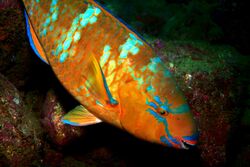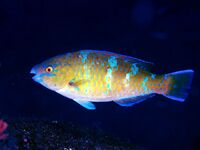Biology:Scarus ghobban
| Scarus ghobban | |
|---|---|

| |
| Scientific classification | |
| Domain: | Eukaryota |
| Kingdom: | Animalia |
| Phylum: | Chordata |
| Class: | Actinopterygii |
| Order: | Labriformes |
| Family: | Scaridae |
| Genus: | Scarus |
| Species: | S. ghobban
|
| Binomial name | |
| Scarus ghobban | |
| Synonyms[3] | |
| |
Scarus ghobban, also known as the blue-barred parrotfish, blue trim parrotfish, cream parrotfish, globe-headed parrotfish, green blotched parrotfish, yellow scale parrotfish, and bluechin parrotfish,[1] is a species of marine ray-finned fish in the family Scaridae.
Description
This species is blue-green to green in colour and commonly grows to approximately 46 cm. Its appearance is variable. It may have a central stripe on the dorsal and anal fins that is pink in color. The underside of the body may be pinkish or yellowish. There may be blue markings around the area of the pectoral fin.[4]
Distribution
Scarus ghobban is widespread throughout the Indo-Pacific, known from East Africa to Indonesia. It also occurs in the Galápagos Islands[4] as well as Japan , south to Australia and east to French Polynesia.[2] Recently recorded in 2001 for the first time in the Mediterranean Sea off Israel, following an entry via the Suez Canal, it is now expanding northward in Levantine waters where it remains rare.[5][6]
Like other reef fish with a pelagic larval phase, regional currents facilitate high levels of gene flow, which in turn create high genetic diversity among the species.[7]
Habitat
Scarus ghobban occurs in places with sandy bottoms and in areas with seagrass. It is also known to live in marginal reefs and in deeper waters.[1]
Ecology
Scarus ghobban grows quickly and can live up to 13 years. It tends to congregate in small schools.[1] Scarus ghobban can rotate their mandible bone at a high velocity; this allows them to function as a scraper and facilitate hydrological transport of fine sediments.[8]
Reproduction The way the scarus ghobban reproduces is by the female laying eggs into the current of the water. After about 25 hours after the egg has been fertilized, it'll hatch. After birth, the parrotfish will mature quickly and won't have to be near its parents for much time.[9]
Threats
While the species is captured in large numbers by fishermen for consumption and sale, and there is also a high amount of bycatch from other fisheries, it is not particularly targeted and appears not to be threatened at this point. As other parrotfish, it is dependent on coral reefs to some degree, and is likely to suffer from the continued degradation of same.[1]
References
- ↑ 1.0 1.1 1.2 1.3 1.4 Choat, J.H.; Myers, R.; Russell, B.; Clements, K.D.; Rocha, L.A.; Lazuardi, M.E.; Muljadi, A.; Pardede, S. et al. (2012). "Scarus ghobban". IUCN Red List of Threatened Species 2012: e.T190705A17798394. doi:10.2305/IUCN.UK.2012.RLTS.T190705A17798394.en. https://www.iucnredlist.org/species/190705/17798394. Retrieved 19 November 2021.
- ↑ 2.0 2.1 McGrouther, Mark (21 January 2019). "Bluebarred Parrotfish, Scarus ghobban Forsskål, 1775". Australian Museum. https://australianmuseum.net.au/learn/animals/fishes/bluebarred-parrotfish-scarus-ghobban-forsskl-1775/.
- ↑ Froese, Rainer and Pauly, Daniel, eds. (2019). "Scarus ghobban" in FishBase. December 2019 version.
- ↑ 4.0 4.1 "Scarus ghobban". Darwin Foundation. http://www.darwinfoundation.org/datazone/checklists/7724/.
- ↑ Atlas of Exotic Fishes in the Mediterranean Sea (Scarus ghobban). 2nd Edition. 2021. 366p. CIESM Publishers, Paris, Monaco.https://ciesm.org/atlas/fishes_2nd_edition/Scarus_ghobban.pdf
- ↑ Bariche, Michel; Saad, Mohammed (2009). "Settlement of the lessepsian blue-barred parrotfish Scarus ghobban (Teleostei: Scaridae) in the eastern Mediterranean". Marine Biodiversity Records 1: e5. doi:10.1017/S1755267205000497.
- ↑ Visram, Shakrim (2010). "Genetic connectivity and historical demography of the blue barred parrotfish (Scarus ghobban) in the western Indian Ocean". Marine Biology 157 (7): 1475. doi:10.1007/s00227-010-1422-8.
- ↑ Melgarejo-Damián, M. P.; González-Acosta, A. F.; Cruz-Escalona, V. H.; Moncayo-Estrada, R. (2017). "A comparison of feeding biomechanics between two parrotfish species from the Gulf of California" (in en). Zoomorphology 137 (1): 165–176. doi:10.1007/s00435-017-0383-6. ISSN 0720-213X. http://link.springer.com/10.1007/s00435-017-0383-6.
- ↑ Jonna R. Jamil (2021) Animal Diversity WebScaridae Parrotfishes https://animaldiversity.org/accounts/Scaridae/
External links
- Photos of Scarus ghobban on Sealife Collection
Wikidata ☰ Q2076448 entry
 |




